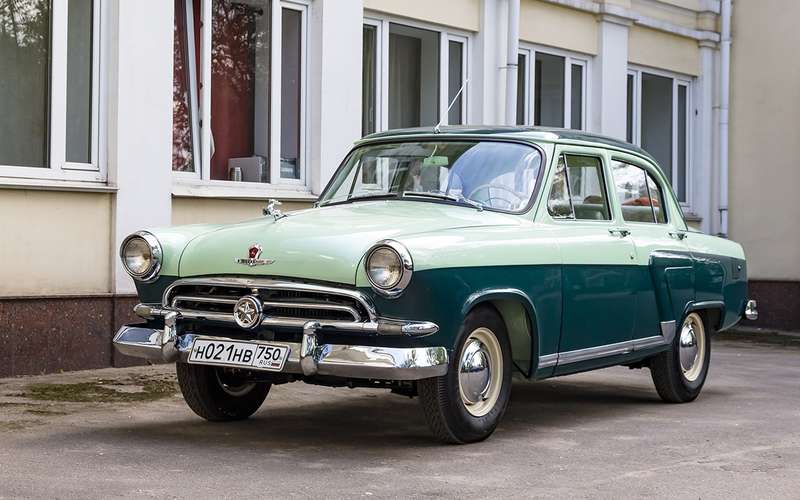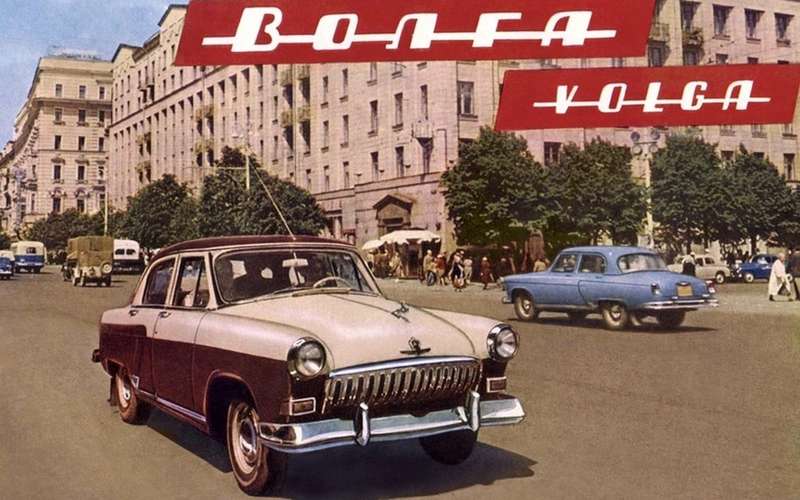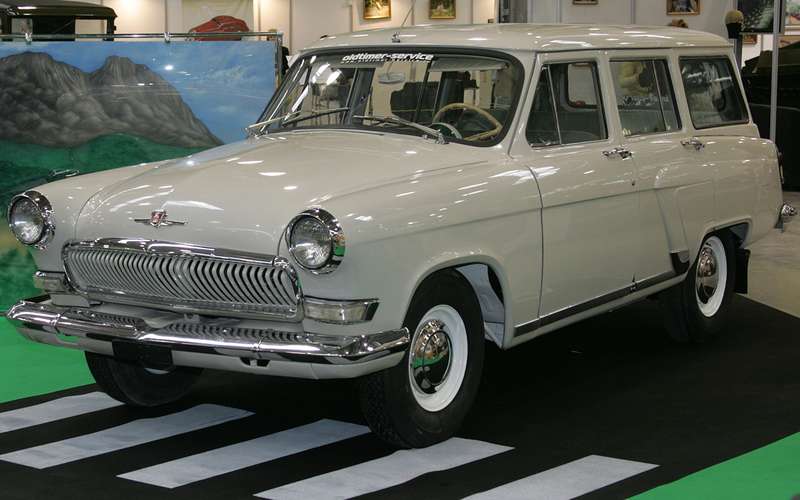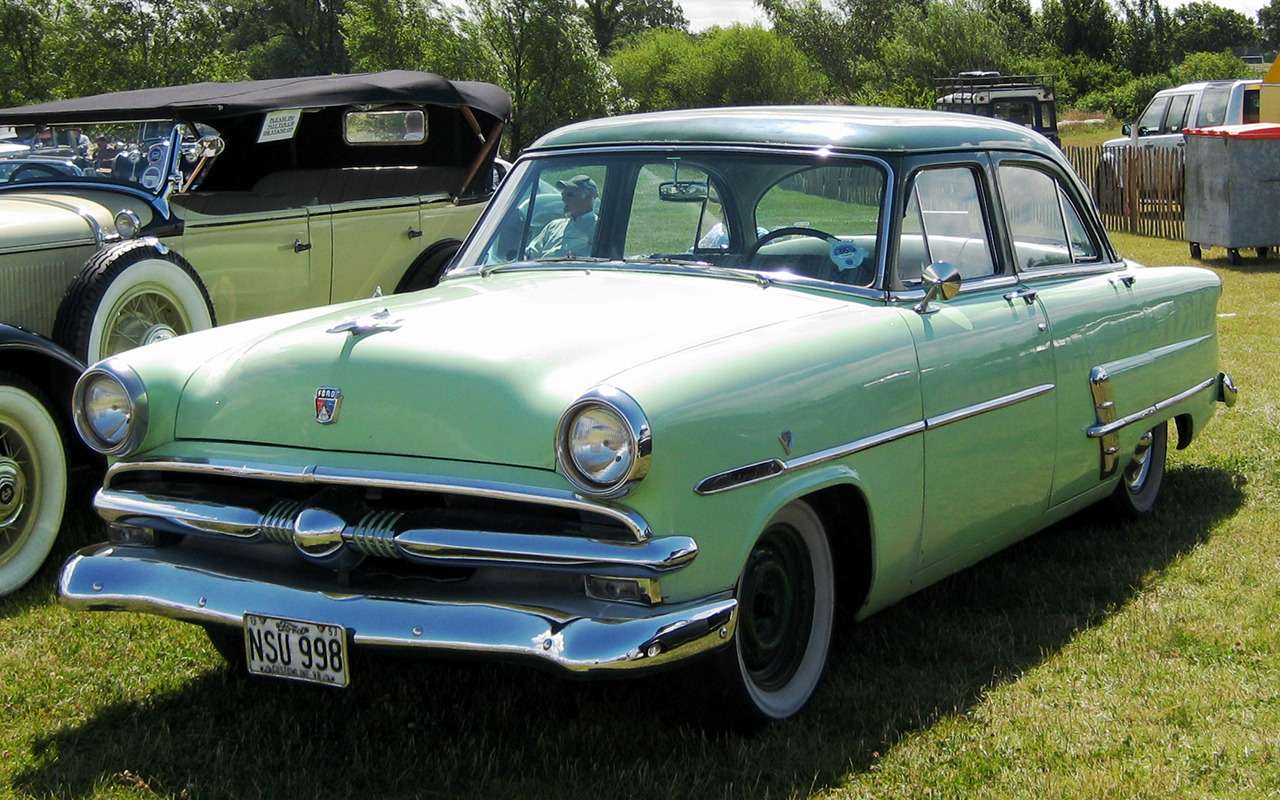She is not a copy!
Any external similarity of the Volga GAZ-M21 (the letter M in the index was used on cars of the so-called first and second series, and in the early 1960s it was officially abandoned) with the American Ford Mainline gave rise to the claim that the Soviet car was copied from this particular model. This is not quite true, but rather – not at all!
Foreign cars available to factory engineers and stylists were carefully studied. In tests, prototypes of the Volga were compared with the same Ford Mainline and Chevrolet Styleline. But the GAZ-M21 looks as much like a Ford as all the cars of those years looked alike. Including the American. In addition, the Volga has a load-bearing body and all overseas models in those years were frame.
Ford Mainline, 1952
A new original progressive overhead valve engine was installed on the GAZ-M21, united in terms of the piston group with the V8 GAZ-13 (cylinder size 92×92 mm). The aircraft in the basic version developed 70 hp.
Later, the power was increased to 75 hp and for some export cars, by increasing the compression ratio, to 80-85 hp. Only on the early versions of the GAZ-M21G, a lower-valve engine was temporarily mounted – a variant of the GAZ-M20 Pobeda engine with a volume increased to 2.4 liters and a power of 65 forces.

However, Ford elements were still present in the Volga. In particular, the well-known bluish transparent cover of the speedometer. And most importantly – an automatic transmission.

The gun didn’t fire
Volga GAZ-M21 – the first serial domestic car with a gun.
The three-stage unit was created on the basis of the Ford design and united with the Chaika GAZ-13 box. But only a few hundred were fired from a Volga with a machine gun.
The complex box required high production culture and competent qualified service.
The seagull was small. And on the GAZ-M21, the machine had to become the basic box. The mechanics were planned only for taxi cars.
Some GAZ-M21 owners with machine guns wrote letters and even came to the factory, demanding that they replace the machine gun with a simple and reliable three-stage mechanics. As a result, the version with a pistol was abandoned altogether. From now on, automatic boxes with V8 engines were installed only on small-scale Volga for special services – GAZ-23.

Why did the star go down?
GAZ-M21 prototypes had a harmonious vertical grid. But the car entered the series with a huge chrome element in the center, and even with a five-pointed star on it.
They said Marshal Georgy Zhukov pushed for such a design during the government’s adoption of the car. But most likely, this is one of the many beautiful legends of the life of the Volga.
Foreign dealers did not like the star – they planned to sell the Volga for export. Representatives of the capitalist countries took this backdrop negatively: it is no longer just the export of cars, but almost propaganda of the revolution. Volga with a star was made only in 1956-1958. And now they are the scarcest.

The cars of the so-called second series, among other improvements, received a neutral grill – a similar wax on the prototypes of 1955. And soon the plant practically left the two-tone color. Such machines were low-tech in production, and GAZ specialists tried to disown them from the very beginning. Left exclusively for export. But soon the fashion for two-tone cars passed.

No worse than foreign cars?
The two-tone Volga of the second series was exhibited in 1958 at the World Exhibition in Brussels, where it received a diploma. But this event was not extraordinary. The exhibition was not a car exhibition and several dozen such diplomas were awarded to various products.
Volga GAZ-21 has never been an excellent car. But in the late 1950s – early 1960s, the car was considered solid, modern and progressive – even against the background of eminent European counterparts. Spacious interior, durability, comfortable suspension, sufficient power.
But by the mid-1960s, the Volga seemed outdated to foreign buyers. Competitors had more powerful engines (compared to even the forced Gorky with 85 horsepower), boxes with four and five gears, and as an option – automatic. The ideas about what controllability should be have also changed.

In the Union, where the GAZ-21 simply had nothing to compare with, the Volga remained the standard and the dream of millions. But interest in the car in foreign markets has declined sharply.
Driving for export
Foreign experts paid tribute to the Volga in the 1960s for its strength, cross-country ability, high-quality workmanship and craftsmanship.
But the dynamics, and especially the handling of the car on soft suspension and with far from the most perfect steering, caused sarcasm among Western journalists.
The Belgian company Scaldia-Volga, the largest importer of our cars, even made a restyled version of the GAZ-21. And she put Rover diesels on the Volga. First – a 1.6 liter capacity with a power of only 43 horsepower, then – a 2.3 liter 65 horsepower.
The main asset of the diesel Volga was, of course, efficiency. But dozens of such machines have been made.

A little more – about a hundred right-hand drive vehicles (of which a dozen and a half GAZ-22P station wagons) were assembled in Gorky for export to the UK and other left-hand drive countries. The demand for such machines was also small.
Mark by history

The GAZ-21 was made in many modifications (including export versions, different in finish) until 1970. They also produced taxi-sedans – third-generation cars with separate front seats, GAZ-22 station wagons and ambulances based on it.
They also made small-scale GAZ-23 with V8 engine for the KGB.
Of all modifications, a total of 638,875 vehicles were produced.

In 1965, NAMI built a restyled prototype of the Volga (the so-called fourth edition) by designer Eduard Molchanov. But the factory was not interested in it, because it was already working on the Volga GAZ-24.
By 1970, the design and design of the first Volga were completely obsolete. But in our country, the GAZ-21 was still respected, valued and considered prestigious. Even badly worn, but well cared for, strong cars worked for private dealers for decades. Fortunately, many parts and assemblies of later models were suitable for them.
Now the legendary first-generation Volga is once again considered a highly respected and prestigious car. But already as a venerable retro. And she deserved it.
- “Driving” can also be read on Viber.
GAZ-21 is the most iconic model in the history of the Gorky Automobile Plant. There are many myths and legends associated with it. Sometimes very beautiful.

Source: Z R










